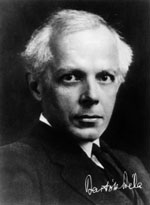Born in 1881 in Hungary, Bartók began piano lessons with his mother at the age of five. He studied piano and composition at the Royal Academy of Music in Budapest, where he created a number of works that echoed the style of Brahms and Richard Strauss. After graduating, he discovered Austro-Hungarian and Slavic folk music, travelling extensively with his friend Zoltán Kodály and recording countless ethnic songs and dances which began to influence his own compositions. Kodály also introduced him to the works of Debussy in 1907, the year in which he became Professor of Piano at the Budapest Conservatory.
Bartók established his mature style with such scores as the ballet The Miraculous Mandarin and his opera Bluebeard’s Castle. He revived his career as a concert pianist in 1927 when he gave the première of his First Piano Concerto in Mannheim.
Bartók detested the rise of Fascism and in October 1940 he quit Budapest and travelled to the USA. At first he concentrated on ethno-musicological researches, but eventually returned to composition and created a significant group of ‘American’ works, including the Concerto for Orchestra and his Third Piano Concerto.
His character was distinguished by a firm, almost stubborn refusal to compromise or be diverted from his musical instincts by money or position. Throughout his working life, Bartók collected, transcribed and annotated the folk-songs of many countries, a commitment that brought little financial return or recognition but one which he regarded as his most important contribution to music.
from notes by LSO Live © 2014
Né en Hongrie en 1881, Bartók prend ses premières leçons de piano avec sa mère à l’âge de cinq ans. Il étudie le piano et la composition à l’Académie royale de musique de Budapest, où il écrit un certain nombre de pièces qui trahissent l’influence stylistique de Brahms et de Richard Strauss. Après l’obtention de ses diplômes, il découvre la musique populaire d’Autriche-Hongrie et des peuples slaves, faisant de nombreuses excursions avec son ami Zoltán Kodály et enregistrant sans relâche des chansons et des danses populaires qui commencent à influencer ses propres compositions. Kodály lui fait également découvrir la musique de Debussy en 1907, année où il est nommé professeur de piano à l’Académie de musique de Budapest.
Le style de maturité de Bartók s’épanouit dans des œuvres comme la pantomime Le Mandarin merveilleux et l’opéra Le Château de Barbe-Bleue. Le compositeur relance sa carrière de pianiste concertiste en 1927, en assurant la création mondiale de son Premier Concerto pour piano à Mannheim.
La montée du fascisme révolte Bartók et, en octobre 1940, il quitte Budapest pour les Etats-Unis. Outre-Atlantique, il se concentre tout d’abord sur des travaux ’ethnomusicologie, mais se remet ensuite à la composition et écrit un ensemble marquant d’œuvres «américaines», avec notamment le Concerto pour orchestre et le Troisième Concerto pour piano.
L’homme se distingue par un refus ferme, presque obstiné de tout compromis, et de toute considération financière ou carriériste qui aurait pu dévier son instinct musical. Tout au long de sa vie, Bartók collecta, transcrivit et annota les chants populaires de nombreux pays, un engagement qui lui apporta peu de satisfactions financières ou de considération, mais qui formait à ses yeux sa contribution la plus importante à la musique.
extrait des notes rédigées par LSO Live © 2014
Bartók wurde 1881 in Ungarn geboren und begann im Alter von fünf Jahren mit Klavierunterricht, bei seiner Mutter. Er studierte Klavier und Komposition an der Königlich-Ungarischen Musikakademie in Budapest, wo er eine Reihe am Stile von Brahms und Richard Strauss geschulter Werke schuf. Nach Beendigung seiner Studien entdeckte Bartók österreichisch-ungarische und slawische Volksmusik und reiste viel mit seinem Freund Zoltán Kodály, wobei er zahllose ethnische Lieder und Tänze aufzeichnete. Dieses Liedgut begann bald seine eigenen Kompositionen zu beeinfl ussen. Kodály führte ihn 1907 auch in die Werke Debussys ein, im gleichen Jahr, in dem er zum Professor für Klavier an der Budapester Musikakademie ernannt wurde.
Bartók fand seinen reifen Stil in solchen Partituren wie das Ballett A csodálatos mandarin (Der wunderbare Mandarin) und die Oper A kékszakállú herceg vára (Herzog Blaubarts Burg). 1927 nahm er seine Karriere als Konzertpianist wieder auf, als er die Uraufführung seines 1. Klavierkonzertes in Mannheim bestritt.
Bartók hasste den Aufstieg des Faschismus, und im Oktober 1940 drehte er Budapest den Rücken zu und reiste in die USA. Zuerst konzentrierte er sich auf musikethnologische Forschungen, wandte sich aber schließlich doch wieder dem Komponieren zu und schuf eine bedeutende Gruppe „amerikanischer“ Werke einschließlich des Konzerts für Orchester und seines 3. Klavierkonzerts.
Sein Charakter zeichnete sich durch eine standhafte, fast störrische Weigerung aus, Kompromisse einzugehen oder sich durch Geld oder Position von seinen musikalischen Instinkten ablenken zu lassen. In seinem gesamten Arbeitsleben sammelte, transkribierte und kommentierte Bartók Volkslieder aus vielen Ländern, ein Engagement, das ihm wenig Ruhm oder finanziellen Nutzen einbrachte, das er aber selber für seinen wichtigsten Beitrag zur Musik hielt.
aus dem Begleittext von LSO Live © 2014






